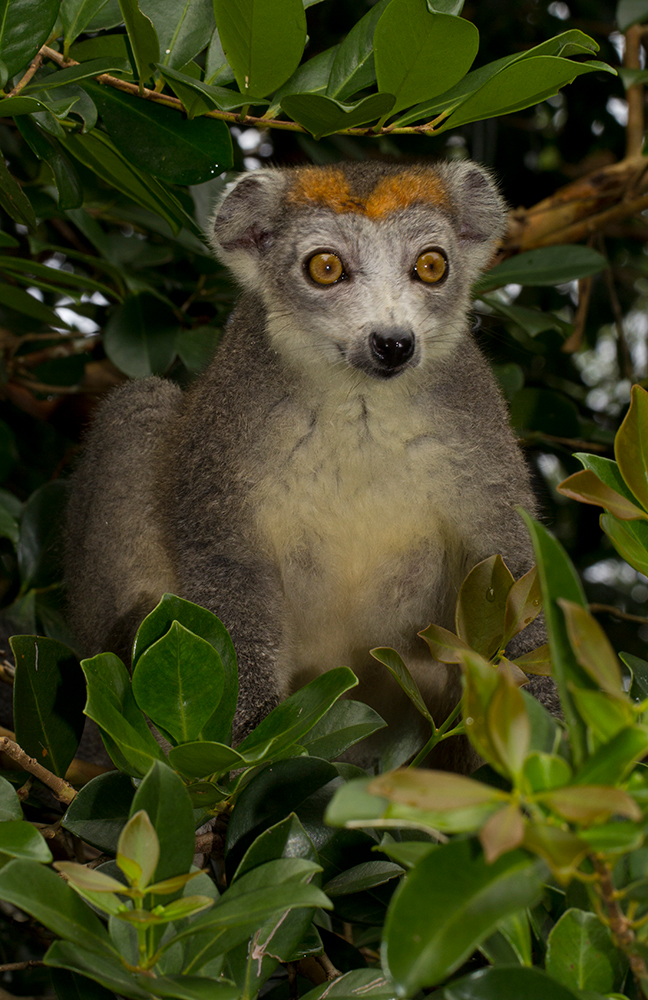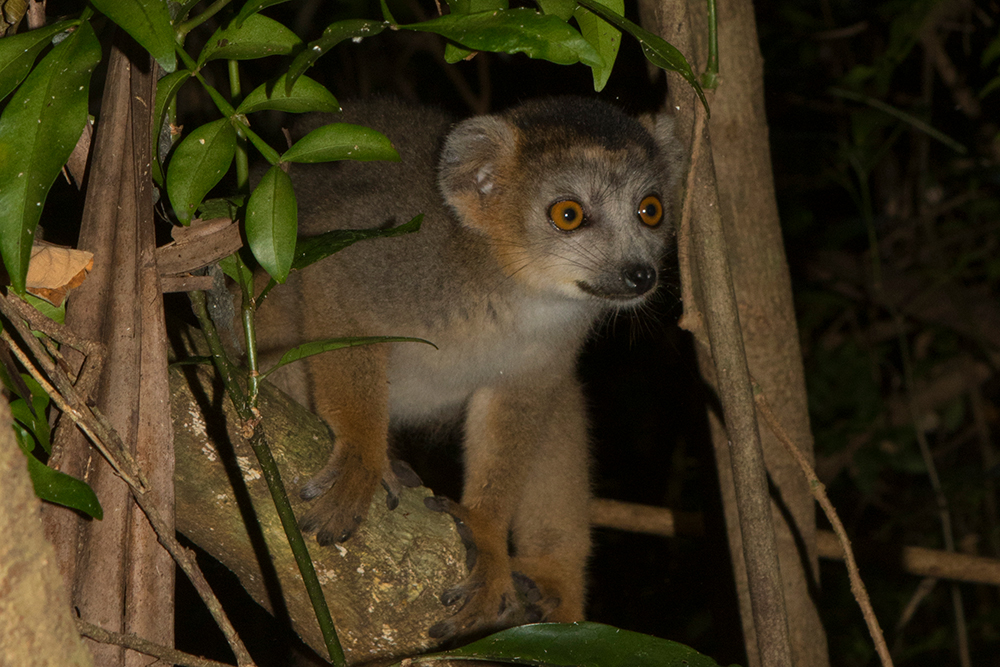The lemurs with the orange crown of fur on their heads may be the smallest of the true lemurs, but they compensate for this with curiosity and adaptability: Crowned Lemurs (Eulemur coronatus). They will not weigh more than one and a half to two kilograms and are only 35 cm tall. The gentlemen of these lemurs wear a black fur cap in the middle of their orange crown, while the ladies only have grey fur between the orange V.
Crowned lemurs are the little kings of the north
Crowned Lemurs live in the far north of Madagascar, among others in the national parks Amber Mountain, Ankarana, Analamerana as well as in the protected area Loky-Manambato and even in the northernmost tip of the island. At Cap d’Ambre there is no other type of lemur except them. The distribution area of the Crowned Lemurs begins approximately on an imaginary line between the cities Ambilobe and Daraina and is limited by the two rivers Mahavavy and Manambato.

The females set the tone
Crowned Lemurs are quite adaptable and populate both dry forests at the coast and rain forests up to 1400 meters above sea level. Even relatively open terrain with savannah-like areas is no problem for them, they cross it after careful consideration of the danger situation on the ground. In Ankarana you can even find them again and again between the razor-sharp Tsingys, the famous needlestone rocks. They jump over the hostile rocks, which no other lemur touches, in the morning and in the evening on their way to their feeding and sleeping places in the forest.
Crowned Lemurs are very social animals and prefer to live in small groups of five or six females with one adult male each. However, the man in his alleged harem doesn’t have much to say: The females tell the Crowned Lemurs the ropes. They are only ready for mating once a month, for the first time at the age of two. However, the males are allowed to mate only at the beginning of the dry season in May and June. Pregnancy of the females lasts about four months, during which the end of the dry season approaches.
The first offspring is born in mid-September, the last in October. With the onset of the rainy season, the forest offers a richly laid table for mother and young, so that the small lemurs now have the best starting conditions. Twins are quite common in Crowned Lemurs and weigh slightly less than 60 grams at birth. They are still completely grey and don’t dare to go on their mother’s back until they are three weeks old. Then it’s also time for first, courageous explorations on their own – even if they miss one or two jumps.
The diet is mostly vegetarian
At the age of six months it is time for the young lemurs to leave their mama’s milk bar. The space on Mom’s back is also getting tight. If the young had already tasted plants and fruits under Mom’s strict eyes, but then always fled to the milk bar, they now have to adapt completely to vegetarian food.
On the menu of a Crowned Lemurs are mainly fruits, but also flowers and pollen. Rarely do insects, leaves or some soil find their place in the stomach of the small lemurs. Also fallen fruit makes a good meal for Crowned Lemurs. During the dry season they are often found in the underground caves of Ankarana, where they quench their thirst in the deep underground lakes and streams.

Crowned lemurs are an endangered species
Crowned Lemurs unfortunately like to plunder one or the other mango or lychee plantation in the rainy season, which brings them not only friends under the Madagascans. They are often hunted, but not only as fruit thieves: in some restaurants in the north the meat of the Crowned Lemurs is secretly on the menu. Several Crowned Lemurs are taken as young animals from the wilderness in order to raise them as bad pet lemurs. Isolated from their conspecifics, misshaped on humans and usually fed completely wrongly, they then live a short existence in human care. Of course, both is not allowed, neither hunting nor keeping in private hands. However, in many places in Madagascar there is a lack of enforcement of existing laws.
However, the biggest threat to Crowned Lemurs is the dwindling habitat. Slash-and-burn, gemstone and gold mines as well as logging for coal, precious wood and firewood have long reduced the forests of the north to the few protected areas. There are no forest corridors between the parks and reserves, so that the individual Crowned Lemurs populations live largely isolated from each other. On the IUCN red list, Crowned Lemurs are now listed as endangered. Estimates amount to a maximum of 10,000 remaining individuals.
Outside the red island you can find Crowned Lemurs only in zoos. This is also an opportunity for the species: Should the natural population of the animals continue to shrink, the genetic diversity in Madagascar could be supplemented by Crowned Lemurs raised in zoos. By the way, they reach an impressive age in captivity: 29 years old became the oldest known Crowned Lemur from the Duke Lemur Center in England.
The best place to observe them is in the Camp des Princes in Ankarana National Park, the protected area Loky-Manambato in northern Madagascar and the Akanin’ny Nofy reserve south of Toamasina (Tamatave), where they were successfully settled. In both places the Crowned Lemurs are hardly shy, but all the more curious and can be observed at close range.
 MADAMAGAZINE Your Magazine about Madagascar
MADAMAGAZINE Your Magazine about Madagascar




